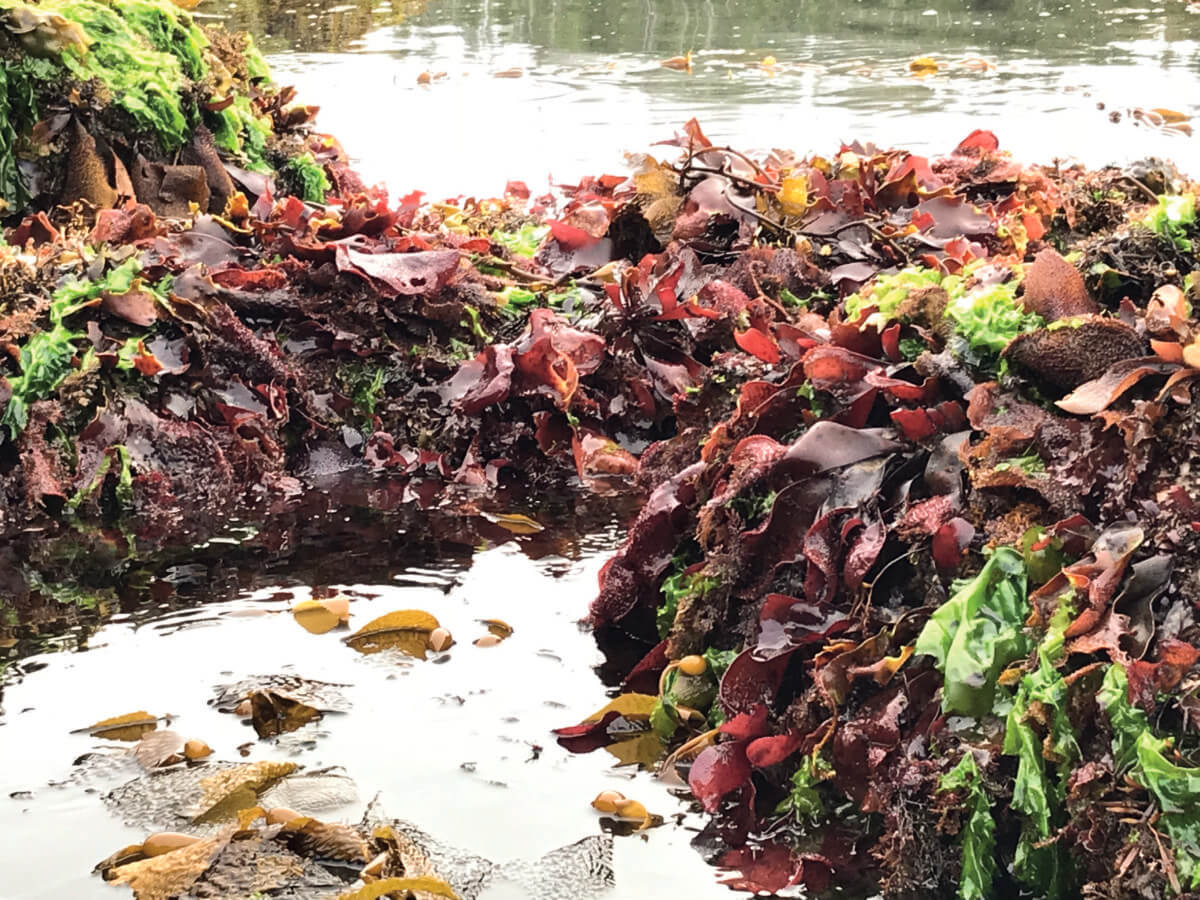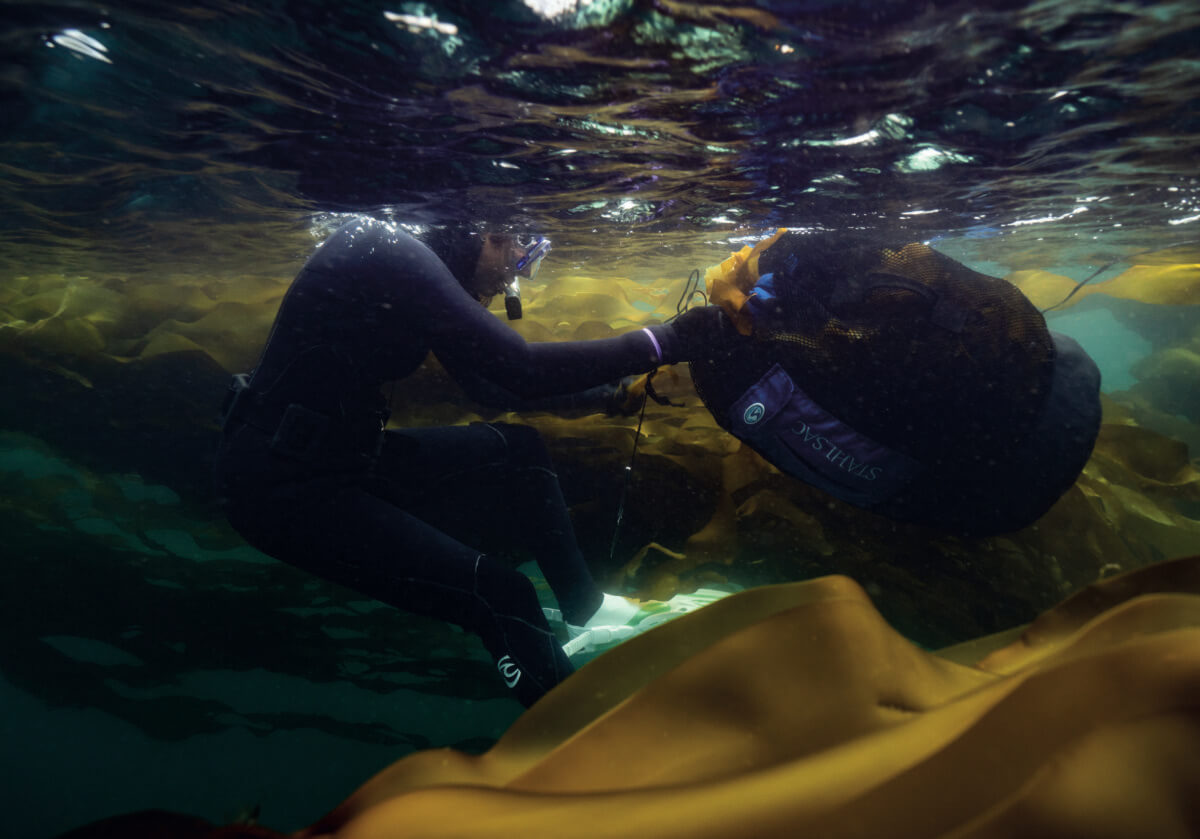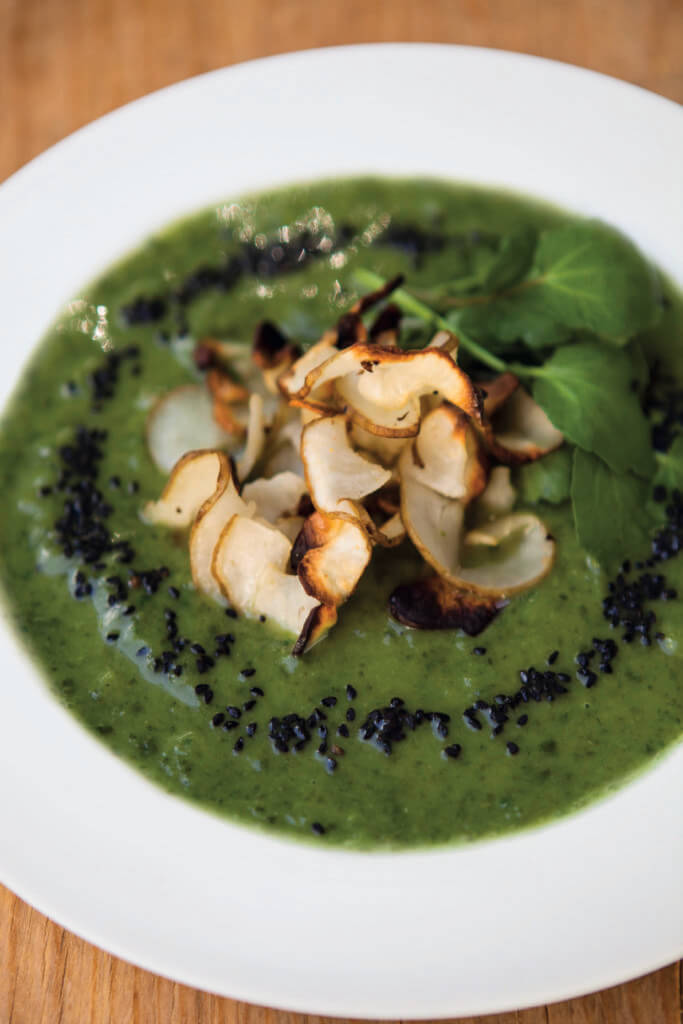Think of harvesting seaweed like giving the plant a haircut, leaving the root so it can grow all year, and other useful tips to ensure a sustainable harvest.

Seaweeds are among the fastest‑growing organisms on the planet and are very regenerative if they are harvested properly. The number one rule for harvesting sustainably is: do not rip the seaweed from the rock. Always leave some of the seaweed attached and harvest by pruning. Here are some key considerations to ensure a sustainable harvest.
Education
For seaweeds to regrow, they not only need to be harvested by leaving some of the seaweed attached to the rock, but they also need to be cut in the right place. The best place to cut the seaweed will depend on the species. Most seaweeds will not regenerate if their stipe (stem‑like structure) is cut. In many seaweeds, the new growth happens in the part of the blade (leaf‑like structure) closest to the stipe. Leaving this part intact and leaving several inches (or more for large kelp) of the blade is important for the seaweed to be able to regenerate. Furthermore, many seaweeds have separate reproductive structures that need to be left intact to ensure they can reproduce. Still other seaweeds are long‑lived perennials and require extra consideration. It is also important to know the ecological role of seaweeds in areas where you are planning to harvest. Take a class and learn about the specific seaweeds you want to wild harvest.
[RELATED: 8 Sea Vegetables You Can Cook With]
In addition, depending on where you are harvesting, a license may be required.
Abundance
Only harvest a particular kind of seaweed if there is an abundance of it growing in the area you are planning to harvest from.
Only Take What You Need and Can Process
Seaweed takes an enormous amount of space to dry. Ensure that you only harvest what you need and what you will be able to dry or process in your space.
Harvesting by Salvaging
Harvesting by salvaging is a great way to be sustainable. Where I live, we routinely get big winds and ocean swell, which rips up healthy seaweeds and deposits them on the beach like treasures for me to find. To determine if the seaweed is still fresh and of adequate quality to be consumed or used in the bath, use your senses. It should smell briny and fresh, it should not be slimy to the touch but should feel lubricated and gelatinous, and the color should look uniform and vivid. For elusive species, or those found only in deep water, salvaging is often the only way to harvest them.
Reciprocity
Practicing reciprocity is essential to sustainability. In healthy ecosystems, there is a balance of give and take among all of the living organisms. When you harvest seaweeds, you become a member of their ecosystem. The organisms that make up an ecosystem function together as a whole, and thus it is essential to listen to the ecosystem and be sensitive to its needs. What can you give back to an ecosystem after taking something, in order to restore balance? Giving back is personal and can be done in many ways. Taking action on local threats to the ecosystem where I harvest and global threats to the larger ocean ecosystem are ways in which I choose to give back. Sharing the love and wonder you have for an ecosystem with your community is a great way to engage people and grow support to protect the health and integrity of local ecosystems.

Photo by Chris Adair.
Commercial Harvest
In the province of British Columbia where I work and live, a commercial seaweed harvester is legally obligated to harvest by pruning and is only allowed to harvest by hand, cutting the seaweed a minimum distance from the holdfast or stipe, which varies depending on the species. As a commercial harvester, I feel very fortunate that our local regulations help to ensure that harvesting is done sustainably.
Where to Harvest
Seaweeds that are being harvested for food should come from clean water. Urban centers and areas near sewage outfalls are not safe places to harvest. Since seaweeds are masters at concentrating the minerals in the water in which they grow, they should be harvested far away from industrial areas such as pulp and paper mills, mines, shipyards and other industrial sites that discharge chemicals or heavy metals into the ocean or upland waterways. Areas with strong tidal currents are better than areas with more stagnant water, as the currents regularly bring water in from the open ocean and flush the old water out.
[RELATED: The Future of Ocean Farming]
Listening to the Ecosystem
As I was preparing to harvest bull kelp one day, many years ago, I had a very strong sense that it was not an appropriate day to be “taking.” I second‑guessed myself and headed out to harvest anyway. As I was walking out of the ocean with a heavy bag full of bull kelp, a wave picked me up and smashed my masked face into the sand. I picked myself up slowly, feeling shocked and disoriented, and began looking around for my bag of bull kelp. Although I searched the area for some time, I never found it. Since then, I take a moment before harvesting to listen to the ecosystem. I ask permission. When I am finished harvesting, I look out at the kelp forest or the intertidal seaweed garden and I say, “Thank you.”
Wild Watercress, Kelp and Cauliflower Soup with Crispy Fermented Jerusalem Artichokes

Photo by Laura Jany.
“This is a beautiful, vibrant green spring soup that comes together quickly and is simple to prepare. Wild watercress has a refreshing, clean and peppery flavor that is balanced out by the deeply savory umami taste of kelp, while cauliflower lends its silky texture to this mineral‑rich spring‑ time soup. Prepare the fermented Jerusalem artichokes at least three days in advance.”—Laura Jany, wild food forager, Kelowna, BC
INGREDIENTS
Crispy Fermented Jerusalem Artichokes
3–4 Jerusalem artichokes (sunchokes)
2 Tbsp (30 mL) pickling spice
6 cloves garlic
1 Tbsp (15 mL) Himalayan sea salt Garlic salt to taste
Olive oil
Wild Watercress, Kelp and Cauliflower Soup
1 medium onion
2 medium carrots, peeled
2 stalks celery1 leek
3 Tbsp (45 mL) unsalted butter
1 cup (250 mL) cauliflower florets
3–5 strips dried bull kelp
3 bunches fresh wild watercress, roughly chopped
Sour cream or coconut milk (optional)
Salt (optional)
INSTRUCTIONS
PREPARE FERMENTED JERUSALEM ARTICHOKES
Note: It isn’t necessary to ferment the Jerusalem artichokes prior to roasting. It does, however, add a tangy flavor and supports ease of digestion. If you prefer to skip the fermentation process, simply wash the Jerusalem artichokes, then proceed to the roasting steps.
To ferment: Gather enough Jerusalem artichokes to fill a small jar. Wash the tubers but do not peel. Add 2 tablespoons (30 mL) of pickling spice and 6 garlic cloves to a medium jar. Add tubers, leaving an inch (2.5 cm) of space at the top.
Dissolve Himalayan sea salt in 4 cups (1 L) of filtered water, then pour into the jar, ensuring the tubers are covered. Close jar and leave at room temperature until fermentation begins, about 3 to 4 days. When the contents are actively bubbling, store the jar in the fridge until ready to use. (The fermented Jerusalem artichokes will keep for up to 1 month.)
PREPARE WATERCRESS, KELP AND CAULIFLOWER SOUP
Preheat oven to 425F (220C) and line a baking sheet with parchment.
Peel and roughly chop onion, carrots, celery and leek. In a large saucepan, melt butter and add onion, carrots, celery, leek, cauliflower and kelp strips. Stir and cook until onion is translucent, 5 to 6 minutes. Add enough water to cover vegetables and bring to a boil, then reduce to a simmer and cover. Simmer until vegetables have softened, about 15 to 20 minutes.
ROAST CRISPY FERMENTED JERUSALEM ARTICHOKES
While the soup cooks, slice raw or fermented Jerusalem artichokes thinly with a mandoline. Use a paper towel to pat the slices dry. Toss slices with garlic salt and a drizzle of olive oil until coated. Roast on the prepared baking sheet until the edges are starting to brown and chips are crispy, about 20 minutes, tossing occasionally to ensure even roasting.
FINISH SOUP AND SERVE
Remove soup from heat, add watercress and cover. Allow the greens to gently wilt, about 2 to 3 minutes. Use an immersion blender to purée soup to a smooth consistency.
Ladle puréed soup into bowls. Stir in a spoonful of sour cream or coco‑ nut milk, if using. Add salt to taste if needed (bull kelp often provides enough salt and additional salt may not be necessary). Garnish with Crispy Fermented Jerusalem Artichokes.
Excerpted with permission from The Science and Spirit of Seaweed: Discovering Food, Medicine and Purpose in the Kelp Forests of the Pacific Northwest by Amanda Swinimer (Harbour Publishing, April 26).
Very “folksy” story but technically full of misinformation.
There are over 12,000 different weeds and each requires becoming familiar with the peculiarities of each specific species. Many commercial species are harvested “whole” and the seaweeds beds are OK.
If one is familiar with a couple of species, pls post regarding only these species, at specific locations and times.